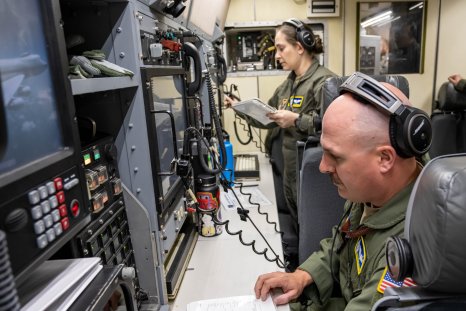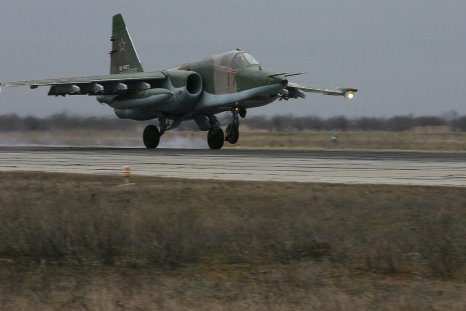NATO reconnaissance missions above the waters west of Russia-occupied Crimea continued this month, despite a recent warning from Moscow about the intensity of U.S. spy flights over the Black Sea.
A British Royal Air Force RC-135W Rivet Joint, an electronic intelligence-gathering aircraft, flew a two-hour sortie off the coast of Romania on Monday, about 150 miles west of Russia's Black Sea Fleet garrison of Sevastopol, according to GPS signals captured on Flightradar24.
Crimea, annexed by Russian forces in a decade ago, has been the target of repeated Ukrainian missile strikes. Last month, Moscow said Washington was supplying Kyiv with precise coordinates for its targeted hits.
The flight-tracking data from the Black Sea showed the British surveillance plane relieving an American P-8A Poseidon maritime patrol aircraft, which had been patrolling the same area.
The U.S. Navy submarine hunter, operating out of Naval Air Station Sigonella in Sicily in southern Italy, appeared to remain within Romania's borders rather than over the Black Sea. It flew a similar pattern on Sunday.
Open-source flight data put the same Rivet Joint in waters off the Romanian port city of Constanta on July 15 for a three-hour reconnaissance sortie in the Black Sea.
Earlier this month, military chatter on Telegram suggested Russian fighter jets challenged a British spy plane near Romania's Black Sea coast on July 1, the same day Flightradar24 showed a Rivet Joint of a different registration operating in the area.
NATO's Allied Air Command did not immediately reply to written questions about Russian air intercepts this week. Russia's defense ministry could not be reached for comment.
Britain's RAF says sophisticated sensors on the Rivet Joint "'soak up' electronic emissions from communications, radar and other systems." The U.S. Air Force, which has 17 Rivet Joints in its inventory, says the platform provides "near real time on-scene intelligence collection, analysis and dissemination capabilities."
The RC-135 family of reconnaissance airframes, each of which carries a mission crew of more than two dozen, was first flown in the 1960s and 1970s. They are expected to remain in service well into the 2040s.
Britain's three Rivet Joints operate out of RAF Waddington in Lincolnshire, on the country's east coast, and have supported NATO missions on the alliance's southeastern flank since to the start of the Russia-Ukraine war, with one involved in a near miss with Russian fighter aircraft in 2022.
Their return to the Black Sea this month for intelligence, surveillance and reconnaissance, or ISR—what the U.K. calls intelligence, surveillance, target acquisition and reconnaissance, or ISTAR—comes after at least five similar missions in June.
On June 28, a U.S. Air Force RC-135V Rivet Joint from RAF Mildenhall in southeast England also scanned the Black Sea from within Romania's borders, according to Flightradar24.
ISR or ISTAR missions in the Black Sea have been linked to strikes on nearby Russian assets by Ukraine's armed forces.
The same day as the U.S. Rivet Joint flight in the area, Russia's defense ministry had noted an "increased intensity" of American surveillance drone flights, which it said were used to "conduct intelligence and targeting for precision weapons supplied to the Ukrainian military by Western countries."
"It shows an increased involvement of the U.S. and other NATO countries in the conflict in Ukraine on the side of the Kyiv regime," according to the ministry, which said the activity raised the likelihood of "airspace incidents" involving Russian aircraft.
"NATO countries will be responsible for this," it said.
The U.S. Defense Department typically declines to comment on specific operations. Pentagon officials have said U.S. forces will continue to operate wherever international law allows.
Disclaimer: The copyright of this article belongs to the original author. Reposting this article is solely for the purpose of information dissemination and does not constitute any investment advice. If there is any infringement, please contact us immediately. We will make corrections or deletions as necessary. Thank you.



